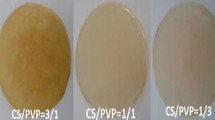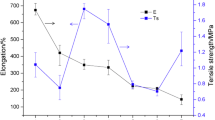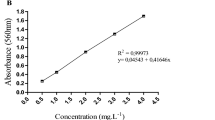Abstract
Polymeric blends between chitosan and poly(epichlorohydrin) (PECH) modified with sodium hydrogen squarate were prepared by the casting method, using formic acid (85%) as the solvent. The compatibility of the blends was studied by different methods, such as Fourier transform infrared spectroscopy, Raman spectroscopy, and thermogravimetric analyses. Cytotoxicity assays were also performed by the direct contact method to assess the feasibility of using these materials in veterinary devices. Based on the analysis results, we concluded that these polymers are compatible due to the interaction between the NH3+ chitosan groups and CO− groups of the modified poly(epichlorohydrin), as well the hydrogen bond between the chlorine atom of the modified poly(epichlorohydrin) and the hydrogens of the chitosan methyl group. It is important to highlight that electrostatic interactions are also responsible for the non-toxicity of these materials in bovine fibroblast cells, which indicates the feasibility of their use in veterinary devices for cattle.








Similar content being viewed by others
References
Merrifield RB (1963) Solid phase peptide synthesis. I. The synthesis of a tetrapeptide. J Am Chem Soc 85(14):2149–2154. https://doi.org/10.1021/ja00897a025
Kennedy FR (1989) Syntheses and separations using functional polymers Edited by D. C. Sherrington and P. Hodge, John Wiley & Sons, Chichester, 1988. pp. 454. ISBN 0-471-91848-2. Br Polym J 21(4):359–360. https://doi.org/10.1002/pi.4980210415
Schnatter WFK (1992) Functionalized polymers and their applications, by A. Akelah and A. Moet, Chapman and Hall, London, 1990, 345 pp. J Polym Sci Part A Polym Chem 30(11):2473. https://doi.org/10.1002/pola.1992.080301123
Pérez M, Ronda JC, Reina JA, Serra A (2001) Synthesis of functional polymers by chemical modification of PECH and PECH–PEO with substituted phenolates. Polymer 42(1):1–8. https://doi.org/10.1016/S0032-3861(00)00352-9
Tiemblo P, Guzmán J, Riande E, Mijangos C, Reinecke H (2001) The gas transport properties of PVC functionalized with mercapto pyridine groups. Macromolecules 35(2):420–424. https://doi.org/10.1021/ma010656s
Herrero M, Quéméner E, Ulvé S, Reinecke H, Mijangos C, Grohens Y (2006) Bacterial adhesion to poly(vinyl chloride) films: effect of chemical modification and water induced surface reconstruction. J Adhes Sci Technol 20(2–3):183–195. https://doi.org/10.1163/156856106775897801
Lisa G, Avram E, Paduraru G, Irimia M, Hurduc N, Aelenei N (2003) Thermal behaviour of polystyrene, polysulfone and their substituted derivatives. Polym Degrad Stab 82(1):73–79
Pérez M, Reina JA, Serra A, Ronda JC (2000) New evidences of the degradation mechanism of poly(oxy-1-chloromethylethylene) with basic reagents: studies with poly (oxy-l-chloromethyl-ethylene-co-oxyethylene). Polymer 41(20):7331–7337. https://doi.org/10.1016/S0032-3861(00)00081-1
Pérez M, Ronda JC, Reina JA, Serra A (2000) Studies on the microstructure of the polymer obtained by chemical modification of poly(oxy-1-chloromethyl-ethylene-co-oxyethylene) (PECH-PEO) with phenolate. Polymer 41(7):2349–2358. https://doi.org/10.1016/S0032-3861(99)00423-1
Otsu T, Yoshida M (1982) Role of initiator-transfer agent-terminator (iniferter) in radical polymerizations: polymer design by organic disulfides as iniferters. Die Makromolekulare Chemie Rapid Commun 3(2):127–132. https://doi.org/10.1002/marc.1982.030030208
Iizawa T, Nishikubo T, Ichikawa M, Sugawara Y, Okawara M (1985) Substitution and elimination reactions of poly(epichlorohydrin) and poly(2-chloroethyl vinyl ether) using phase transfer catalysis. J Polym Sci Polym Chem Ed 23(7):1893–1906. https://doi.org/10.1002/pol.1985.170230705
Navarro R, Pérez M, Rodriguez G, Reinecke H (2007) Selective nucleophilic substitution reactions on poly(epichlorohydrin) using aromatic and aliphatic thiol compounds. Eur Polym J 43(10):4516–4522. https://doi.org/10.1016/j.eurpolymj.2007.07.033
Lee J-C, Litt MH, Rogers CE (1997) Synthesis and properties of (Alkylthio)methyl-substituted poly(oxyalkylene)s and (Alkylsulfonyl)methyl-substituted poly(oxyalkylene)s. Macromolecules 30(13):3766–3774. https://doi.org/10.1021/ma970163g
Lee J-C, Litt MH, Rogers CE (1998) Miscibility behaviors of (Alkylsulfonyl)methyl-substituted poly(oxyalkylene) blends. Macromolecules 31(13):4232–4239. https://doi.org/10.1021/ma971813j
de Oliveira VE, Freitas MCR, Diniz R, Yoshida MI, Speziali NL, Edwards HGM, de Oliveira LFC (2008) Crystal structure and vibrational spectra of some metal complexes of pseudo-oxocarbon bis(dicyanomethylene)squarate in its cis and trans forms. J Mol Struct 881(1–3):57–67. https://doi.org/10.1016/j.molstruc.2007.08.029
Teles WM, Farani RdA, Maia DS, Speziali NL, Yoshida MI, de Oliveira LFC, Machado FC (2006) Crystal structure, thermal analysis and spectroscopic properties of Tetrabutylammonium 3,5-bis(dicyanomethylene)-cyclopentane-1,2,4-trionate: an intriguing pseudo-oxocarbon and its zinc(II) complex. J Mol Struct 783(1–3):52–60. https://doi.org/10.1016/j.molstruc.2005.08.020
Cascone MG, Barbani N, Cristallini C, Giusti P, Ciardelli G, Lazzeri L (2001) Bioartificial polymeric materials based on polysaccharides. J Biomater Sci Polym Ed 12(3):267–281. https://doi.org/10.1163/156856201750180807
Wang X, Wu P, Hu X, You C, Guo R, Shi H, Guo S, Zhou H, Chaoheng Y, Zhang Y, Han C (2016) Polyurethane membrane/knitted mesh-reinforced collagen–chitosan bilayer dermal substitute for the repair of full-thickness skin defects via a two-step procedure. J Mech Behav Biomed Mater 56:120–133. https://doi.org/10.1016/j.jmbbm.2015.11.021
Liu Y, Ma L, Gao C (2012) Facile fabrication of the glutaraldehyde cross-linked collagen/chitosan porous scaffold for skin tissue engineering. Mater Sci Eng 32(8):2361–2366. https://doi.org/10.1016/j.msec.2012.07.008
Elgadir MA, Uddin MS, Ferdosh S, Adam A, Chowdhury AJK, Sarker MZI (2015) Impact of chitosan composites and chitosan nanoparticle composites on various drug delivery systems: a review. J Food Drug Anal 23(4):619–629. https://doi.org/10.1016/j.jfda.2014.10.008
Cheng Y-H, Tsai T-H, Jhan Y-Y, Chiu AW-H, Tsai K-L, Chien C-S, Chiou S-H, Liu CJ-l (2016) Thermosensitive chitosan-based hydrogel as a topical ocular drug delivery system of latanoprost for glaucoma treatment. Carbohydr Polym 144:390–399. https://doi.org/10.1016/j.carbpol.2016.02.080
Anirudhan TS, Divya PL, Nima J (2016) Synthesis and characterization of novel drug delivery system using modified chitosan based hydrogel grafted with cyclodextrin. Chem Eng J 284:1259–1269. https://doi.org/10.1016/j.cej.2015.09.057
Tsiourvas D, Sapalidis A, Papadopoulos T (2016) Hydroxyapatite/chitosan-based porous three-dimensional scaffolds with complex geometries. Mater Today Commun 7:59–66. https://doi.org/10.1016/j.mtcomm.2016.03.006
Kanimozhi K, Khaleel Basha S, Sugantha Kumari V (2016) Processing and characterization of chitosan/PVA and methylcellulose porous scaffolds for tissue engineering. Mater Sci Eng 61:484–491. https://doi.org/10.1016/j.msec.2015.12.084
Barros AAA, Alves A, Nunes C, Coimbra MA, Pires RA, Reis RL (2013) Carboxymethylation of ulvan and chitosan and their use as polymeric components of bone cements. Acta Biomater 9(11):9086–9097. https://doi.org/10.1016/j.actbio.2013.06.036
Meng D, Dong L, Wen Y, Xie Q (2015) Effects of adding resorbable chitosan microspheres to calcium phosphate cements for bone regeneration. Mater Sci Eng 47:266–272. https://doi.org/10.1016/j.msec.2014.11.049
Mattioli-Belmonte M, Cometa S, Ferretti C, Iatta R, Trapani A, Ceci E, Falconi M, De Giglio E (2014) Characterization and cytocompatibility of an antibiotic/chitosan/cyclodextrins nanocoating on titanium implants. Carbohydr Polym 110:173–182. https://doi.org/10.1016/j.carbpol.2014.03.097
Xin-Yuan S, Tian-Wei T (2004) New contact lens based on chitosan/gelatin composites. J Bioact Compat Polym 19(6):467–479. https://doi.org/10.1177/0883911504048410
Wan Y, Lu X, Dalai S, Zhang J (2009) Thermophysical properties of polycaprolactone/chitosan blend membranes. Thermochim Acta 487(1–2):33–38. https://doi.org/10.1016/j.tca.2009.01.007
Pereira AGB, Paulino AT, Nakamura CV, Britta EA, Rubira AF, Muniz EC (2011) Effect of starch type on miscibility in poly(ethylene oxide) (PEO)/starch blends and cytotoxicity assays. Mater Sci Eng 31(2):443–451. https://doi.org/10.1016/j.msec.2010.11.004
Park S-N, Park J-C, Kim HO, Song MJ, Suh H (2002) Characterization of porous collagen/hyaluronic acid scaffold modified by 1-ethyl-3-(3-dimethylaminopropyl)carbodiimide cross-linking. Biomaterials 23(4):1205–1212. https://doi.org/10.1016/S0142-9612(01)00235-6
Georgopoulos SL, Diniz R, Yoshida MI, Speziali NL, Santos HFD, Junqueira GMA, de Oliveira LFC (2006) Vibrational spectroscopy and aromaticity investigation of squarate salts: a theoretical and experimental approach. J Mol Struct 794(1–3):63–70. https://doi.org/10.1016/j.molstruc.2006.01.035
Georgopoulos SL, Diniz R, Rodrigues BL, de Oliveira LFC (2005) Crystal structure and Raman spectra of rubidium hydrogen squarate. J Mol Struct 741(1–3):61–66. https://doi.org/10.1016/j.molstruc.2005.01.048
Souza NLGD, Salles TF, Brandão HM, Edwards HGM, Oliveira LFCd (2015) Synthesis, vibrational spectroscopic and thermal properties of oxocarbon cross linked chitosan. J Braz Chem Soc 26:1247–1256. https://doi.org/10.5935/0103-5053.20150090
Guanaes D, Bittencourt E, Eberlin MN, Sabino AA (2007) Influence of polymerization conditions on the molecular weight and polydispersity of polyepichlorohydrin. Eur Polym J 43(5):2141–2148. https://doi.org/10.1016/j.eurpolymj.2007.02.016
Platzer N (1982) Polymer degradation—principles and practical applications, Wolfram Schnabel, MacMillan, New York, 1982, 227 pp. J Polym Sci Polym Lett Ed 20(9):509. https://doi.org/10.1002/pol.1982.130200907
Souza NLGD, Brandão HM, de Oliveira LFC (2011) Spectroscopic and thermogravimetric study of chitosan after incubation in bovine rumen. J Mol Struct 1005(1–3):186–191. https://doi.org/10.1016/j.molstruc.2011.08.049
Li B, Shan C-L, Zhou Q, Fang Y, Wang Y-L, Xu F, Han L-R, Ibrahim M, Guo L-B, Xie G-L, Sun G-C (2013) Synthesis, characterization, and antibacterial activity of cross-linked chitosan-glutaraldehyde. Mar Drugs 11(5):1534–1552. https://doi.org/10.3390/md11051534
Georgopoulos SL, Edwards HGM, de Oliveira LFC (2013) Raman spectroscopic analysis of the interaction between squaric acid and dimethylsulfoxide. Spectrochim Acta Part A Mol Biomol Spectrosc 111:54–61. https://doi.org/10.1016/j.saa.2013.03.052
Nithya H, Selvasekarapandian S, Selvin PC, Kumar DA, Hema M, Kawamura J (2012) Laser Raman and conductivity studies of plasticized polymer electrolyte P(ECH-EO):propylenecarbonate:γ-butyrolactone:LiClO4. J Solid State Electrochem 16(5):1791–1797. https://doi.org/10.1007/s10008-011-1610-6
Chae SY, Jang M-K, Nah J-W (2005) Influence of molecular weight on oral absorption of water soluble chitosans. J Control Release 102(2):383–394. https://doi.org/10.1016/j.jconrel.2004.10.012
Kean T, Thanou M (2010) Biodegradation, biodistribution and toxicity of chitosan. Adv Drug Deliv Rev 62(1):3–11. https://doi.org/10.1016/j.addr.2009.09.004
Acknowledgements
The authors wish to thank CNPq, CAPES and FAPEMIG (Brazilian agencies) for financial support.
Author information
Authors and Affiliations
Corresponding author
Rights and permissions
About this article
Cite this article
Souza, N.L.G.D., Munk, M., Brandão, H.M. et al. Functionalization of poly(epichlorohydrin) using sodium hydrogen squarate: cytotoxicity and compatibility in blends with chitosan. Polym. Bull. 75, 4627–4639 (2018). https://doi.org/10.1007/s00289-018-2290-5
Received:
Revised:
Accepted:
Published:
Issue Date:
DOI: https://doi.org/10.1007/s00289-018-2290-5




